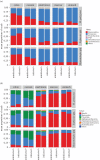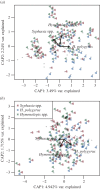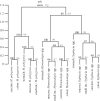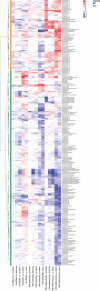Interactions between multiple helminths and the gut microbiota in wild rodents
- PMID: 26150661
- PMCID: PMC4528493
- DOI: 10.1098/rstb.2014.0295
Interactions between multiple helminths and the gut microbiota in wild rodents
Abstract
The gut microbiota is vital to host health and, as such, it is important to elucidate the mechanisms altering its composition and diversity. Intestinal helminths are host immunomodulators and have evolved both temporally and spatially in close association with the gut microbiota, resulting in potential mechanistic interplay. Host-helminth and host-microbiota interactions are comparatively well-examined, unlike microbiota-helminth relationships, which typically focus on experimental infection with a single helminth species in laboratory animals. Here, in addition to a review of the literature on helminth-microbiota interactions, we examined empirically the association between microbiota diversity and composition and natural infection of multiple helminth species in wild mice (Apodemus flavicollis), using 16S rRNA gene catalogues (metataxonomics). In general, helminth presence is linked with high microbiota diversity, which may confer health benefits to the host. Within our wild rodent system variation in the composition and abundance of gut microbial taxa associated with helminths was specific to each helminth species and occurred both up- and downstream of a given helminth's niche (gut position). The most pronounced helminth-microbiota association was between the presence of tapeworms in the small intestine and increased S24-7 (Bacteroidetes) family in the stomach. Helminths clearly have the potential to alter gut homeostasis. Free-living rodents with a diverse helminth community offer a useful model system that enables both correlative (this study) and manipulative inference to elucidate helminth-microbiota interactions.
Keywords: Apodemus flavicollis; community interactions; infracommunity; metagenome; wildlife microbiota.
Figures





Similar articles
-
Comparison of helminth community of Apodemus agrarius and Apodemus flavicollis between urban and suburban populations of mice.Parasitol Res. 2017 Nov;116(11):2995-3006. doi: 10.1007/s00436-017-5609-5. Epub 2017 Sep 14. Parasitol Res. 2017. PMID: 28913695 Free PMC article.
-
Exposure to Parasitic Protists and Helminths Changes the Intestinal Community Structure of Bacterial Communities in a Cohort of Mother-Child Binomials from a Semirural Setting in Mexico.mSphere. 2021 Aug 25;6(4):e0008321. doi: 10.1128/mSphere.00083-21. Epub 2021 Aug 18. mSphere. 2021. PMID: 34406855 Free PMC article.
-
Clinical helminth infections alter host gut and saliva microbiota.PLoS Negl Trop Dis. 2022 Jun 8;16(6):e0010491. doi: 10.1371/journal.pntd.0010491. eCollection 2022 Jun. PLoS Negl Trop Dis. 2022. PMID: 35675339 Free PMC article.
-
Helminth-microbiota cross-talk - A journey through the vertebrate digestive system.Mol Biochem Parasitol. 2019 Oct;233:111222. doi: 10.1016/j.molbiopara.2019.111222. Epub 2019 Sep 18. Mol Biochem Parasitol. 2019. PMID: 31541662 Review.
-
[Progress of research on the interplay between helminth and intestinal protozoa and gut microbiota].Zhongguo Xue Xi Chong Bing Fang Zhi Za Zhi. 2019 Mar 29;31(1):77-85. doi: 10.16250/j.32.1374.2019005. Zhongguo Xue Xi Chong Bing Fang Zhi Za Zhi. 2019. PMID: 31016928 Review. Chinese.
Cited by
-
Geographical location influences the composition of the gut microbiota in wild house mice (Mus musculus domesticus) at a fine spatial scale.PLoS One. 2019 Sep 26;14(9):e0222501. doi: 10.1371/journal.pone.0222501. eCollection 2019. PLoS One. 2019. PMID: 31557179 Free PMC article.
-
Gut microflora may facilitate adaptation to anthropic habitat: A comparative study in Rattus.Ecol Evol. 2018 Jun 14;8(13):6463-6472. doi: 10.1002/ece3.4040. eCollection 2018 Jul. Ecol Evol. 2018. PMID: 30038748 Free PMC article.
-
MICHELINdb: a web-based tool for mining of helminth-microbiota interaction datasets, and a meta-analysis of current research.Microbiome. 2020 Feb 3;8(1):10. doi: 10.1186/s40168-019-0782-7. Microbiome. 2020. PMID: 32008578 Free PMC article.
-
Interactions between parasitic helminths and gut microbiota in wild tropical primates from intact and fragmented habitats.Sci Rep. 2021 Nov 3;11(1):21569. doi: 10.1038/s41598-021-01145-1. Sci Rep. 2021. PMID: 34732823 Free PMC article.
-
Synchronized shift of oral, faecal and urinary microbiotas in bats and natural infection dynamics during seasonal reproduction.R Soc Open Sci. 2018 May 2;5(5):180041. doi: 10.1098/rsos.180041. eCollection 2018 May. R Soc Open Sci. 2018. PMID: 29892443 Free PMC article.
References
Publication types
MeSH terms
Substances
LinkOut - more resources
Full Text Sources
Other Literature Sources

